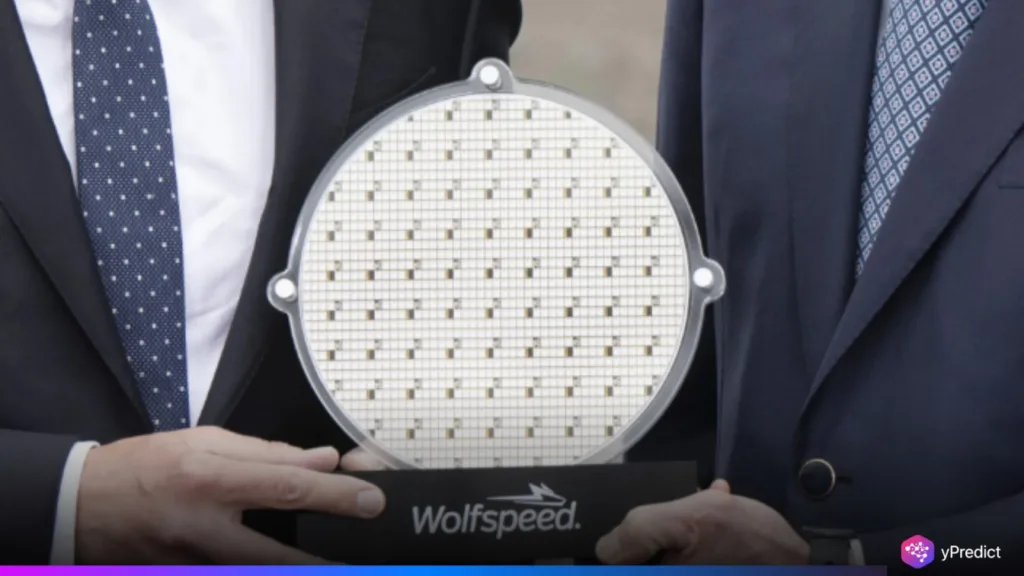
Wolfspeed Inc., a key U.S. semiconductor player and silicon carbide pioneer, announced plans to file for Chapter 11 bankruptcy. The company finalised a sweeping $6.5 billion debt restructuring agreement with creditors to stabilise its operations and balance sheet. Once seen as a flagship CHIPS and Science Act beneficiary, Wolfspeed’s collapse highlights challenges facing America’s semiconductor revival efforts. Its filing comes amid cooling EV and industrial demand, raising concerns about the sustainability of capital-intensive chip manufacturing in the U.S.
Wolfspeed’s Debt Burden and Strategic Bankruptcy Plan
Reuters reports that Wolfspeed, a North Carolina semiconductor firm, will file for bankruptcy under a prearranged restructuring agreement. The plan, backed by creditors and partners like Apollo Global Management and Renesas Electronics, aims to cut Wolfspeed’s $6.5 billion debt. It will reduce debt by nearly 70% and provide fresh financing of $275 million to support ongoing operations and growth. Wolfspeed expects to complete the restructuring process and emerge from bankruptcy by the end of September 2025.
This strategic move comes after months of mounting challenges severely strained Wolfspeed’s finances. Weakened EV demand, shifting U.S. trade policies, and production setbacks undermined its ambitious expansion, as billions in borrowing for new semiconductor plants in New York and North Carolina failed to deliver the expected returns amid deteriorating market conditions.
CEO Robert Feurle, who stepped into the role this year during a leadership overhaul, announced the decision after careful evaluation. He said in a statement that,
After evaluating potential options to strengthen our balance sheet and right-size our capital structure, we have decided to take this strategic step because we believe it will put Wolfspeed in the best position possible for the future.
He emphasised that the restructuring provides the best opportunity to strengthen the balance sheet and secure Wolfspeed’s long-term future. The plan will convert much of Wolfspeed’s unsecured debt, including convertible bonds and loans, into new equity. Existing shareholders will retain only 3% to 5% ownership in the reorganised company once the restructuring is complete.
From Ambitious Growth to Financial Strain
Founded in 1987 as Cree by a group of N.C. State University graduates, the company began as a producer of LED lighting before pivoting under former CEO Gregg Lowe to focus on silicon carbide semiconductors for electric vehicles. This shift led to the rebranding as Wolfspeed, reflecting its ambition to become a leader in EV semiconductor technology.
Therefore, to support this vision, the company borrowed heavily to build major manufacturing facilities in New York and North Carolina. However, production delays, missed targets at its Mohawk Valley plant, and weaker-than-expected EV market demand ultimately strained its financial health.
However, Wolfspeed’s financial troubles worsened when a crucial $750 million CHIPS Act award, approved under the Biden administration, was delayed. The funding depended on debt restructuring, which stalled amid protracted creditor talks and shifting political priorities. As uncertainty mounted, investor confidence collapsed, sending the stock from over $110 to below $1.
Cost-Cutting, Leadership Shifts, and the Road to Recovery
To stabilise its worsening financial position, Wolfspeed launched aggressive cost-cutting initiatives. The company slashed its global workforce by over 25%, shut its Durham device plant, and abandoned plans for a multibillion-dollar facility in Germany. This was followed by major leadership changes as Feurle was named CEO in March, David Emerson became COO in May, and the senior management team was reduced by 30%.
Instead of a limited bond restructuring, Wolfspeed chose a comprehensive plan that converts debt into equity, handing control to creditors. While it expects to generate sufficient cash flow post-restructuring, it hasn’t ruled out seeking additional government support. The company’s path underscores the challenges clean energy and semiconductor firms face amid shifting markets, rising rates, and evolving policies.





